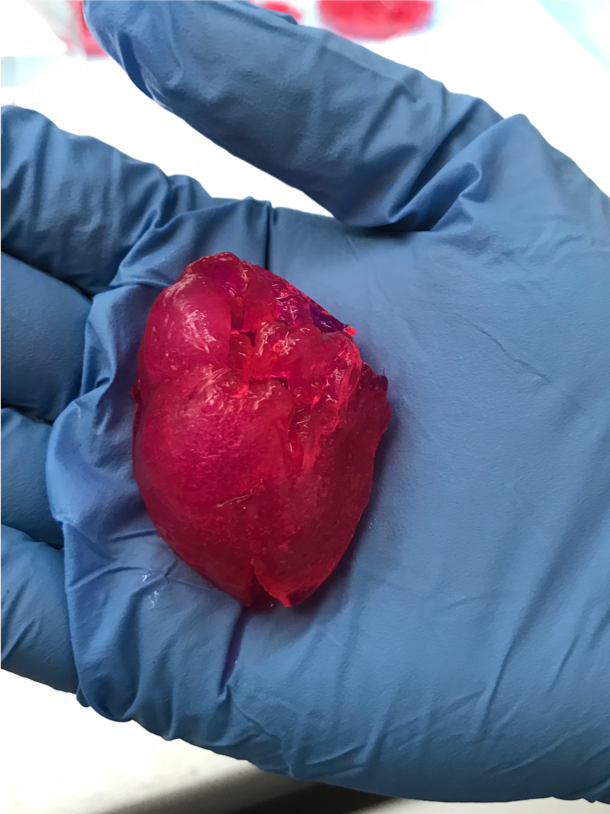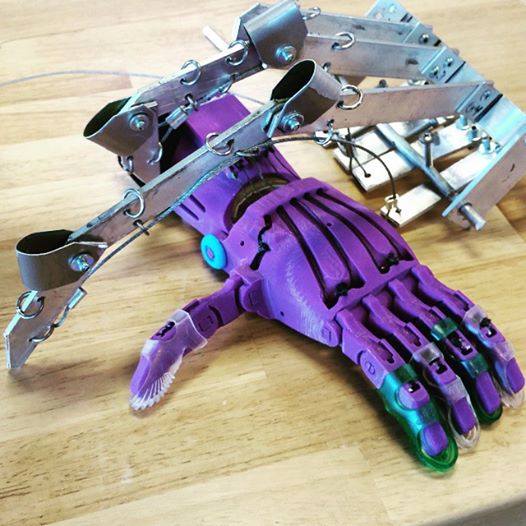The gift of human life is so miraculous that you may find yourself overwhelmed with the complexity of it all if you think too long. The fact that we have streamlined machines for bodies, with numerous efficient, connected systems continually at work within us—from the respiratory system to the nervous system and much more—is extraordinary, to say the least.
You may feel the same way about much technology today too, and understandably so with 3D printing—along with robotics, virtual reality, and even 4D printing. Attempting to comprehend how an inventor like Chuck Hull arrived at the concept of creating such software, hardware, and materials running on so many levels and systems will have you shaking your head. But what about the amazing number of innovations that have come forth via users since the arrival of the first 3D printer in 1983?

3D printed bust of Hull, printed on a 3D Systems ProJet x60 printer, and his famed first 3D printer, the SLA-1.(Photo: National Inventors Hall of Fame)
Researchers today delve deeply not only into what makes the human body tick, but also how to understand, create, and use intricate technology that helps them forge ahead in making discoveries and creating new products and tools for critical applications. And while the medical realm has been heavily impacted by research in 2019 especially, so have many other areas. Beginning with medicine, here are five areas of research that have been the focus of major headlines this year:
Medicine
The innovations within the field of medicine brought forth by 3D printing this year have been spectacular, fascinating—and again, almost beyond comprehension in some ways—for those of us who don’t spend our days in think tanks or in front of microscopes.
It is undeniable that much about 3D printing is fun and games; after all, today you may find a 3D printer in many elementary schools with children learning how to make small objects and trinkets, and you may even find surprisingly young students in your local library in the afternoon or early evening sitting in labs making 3D designs on their own, then watching intently as the layers print one by one from a desktop 3D printer. This is how initial interest turns into a passion for learning and creating, and many of those students may go on to print medical devices such as prosthetics or work on other research projects.
The subject of 3D printing becomes much weightier, however, when we look into the important research that is being done to help patients who may be on the brink of losing their lives–or the quality of life they had always known previously. Researchers are intent on finding better ways to treat patients, especially those who are suffering from cancer and other life-threatening illnesses.
3D models can be made to replicate tumors and help surgeons in many ways, from diagnosis and education of patients and their families to helping medical students train, but ultimately surgeons may be able to prepare for some of the most innovative procedures they have ever performed. A 3D model may be with them for a long period of time, spanning from the time of diagnosis until the time it serves as a surgical guide in the operating room for a procedure centered around pediatric orthopedics, as an example.
Over this past year, medical inventors created a host of implants, devices, and more. And from nearly every reach of the world (developed and still developing), volunteers researched ways to help those in need to receive 3D printed prosthetics, as e-NABLE celebrated their eighth anniversary of helping others.
The potential for 3D printed medications continued to emerge also, along with assorted peripheral devices like dispensers. Bioprinting is the standout highlight this year, again, without question though, and although scientists have not reached the true point of printing replacement organs for the human body that will replace the need for donors and waiting lists, they have continued to create incredibly life-life and useful 3D printed models for treatment and training, a 3D printed titanium sternum for a patient desperately in need, and even a mini-heart-part.

A 3D printed mini-heart (Photo: BIOLIFE4D)
This area of 3D printing is only expected to expand further in 2020, and eventually, researchers will reach the holy grail of bioprinting and manufacturing human organs.

(Photo: BIOLIFE4D)
Materials: 3D Printing with Metal & Composites
While researchers in labs continue to create their own software and hardware to complete complicated research studies (often making modifications to existing 3D printers or using open source ware), the study of materials has expanded far beyond what we would have imagined years ago. Today, not only is 3D printing with metal continuing to grow, researchers are learning more about composites that can strengthen metal powders, like particle reinforced metal composites, helpful in major applications and industries like aerospace, automotive and much more.

Schematic of nanoparticle distribution in TiC/Ti nanocomposite powders produced by ball milling and direct mixing, prepared for SLM. (Photo: Singapore University of Technology and Design)
Combinations of additives and metals (as well as polymers) open up even more options to scientists, but also manufacturers in nearly every industry, from carmakers to the military. 3D printing with metal in space has been a focal point for researchers too, advancing in the micro- or zero-gravity environment.
Aerospace
Scientists never seem to tire of research regarding space travel, colonization, materials for building on-demand away from Earth, and so much more. While of course much of the research is driven by NASA, the public is continually fascinated by the idea of traveling to Mars in the near future—or any type of space colonization, which of course must be accompanied by a variety of options in construction, to include robotics. Again, materials and composites are an important area of study for researchers, such as sintering thermoset composites at high temperatures, and other research into aerospace technology.

From ‘Sintering Thermoset Composites at High Temperatures for Aerospace Applications‘ (Image: ‘Laser Sintering of Thermoset Polyimide Composites’)
Many different engine components have been created too, along with extensive research studies regarding engine thrusters and other parts for optimizing rockets and satellite technology.
Construction
While the reality of 3D printed housing being available to all in the very near future may be a stretch, advances have been made in the fabrication of constructions on all levels from offices to nice houses to tiny homes and possible affordable housing.
Massive 3D printers have been manufactured by researchers in numerous countries, with the idea of offering incredible benefits to construction companies such as affordability, on-demand (and rapid) production, less need for men on the job, and more. These printers may also be capable of creating entire communities quickly.

The WASP 3D printer will fabricate circular, affordable housing. (Image: WASP 3D)
Harkening back to the study of materials, concrete is of ongoing interest as researchers find a multitude of ways to extrude what has always been a very conventional substance. Now, scientists are making alternatives for construction such as concrete foam panels, geo-polymer concrete meant to replace conventional manufacturing methods, along with creating more lightweight spatial structures—using one of the greatest benefits in 3D printing as much lighter parts can be made—and often, parts that simply were not possible to create before at all via traditional techniques.

Concrete foam panels (Photo: ‘Fiber-reinforced lightweight foamed concrete panels suitable for 3D printing applications’)
Energy and Power Generation
From porous anodes to new techniques for creating batteries, researchers continue to find new ways to store energy—as well as creating it. Wind turbines have received a lot of attention from the 3D printing realm, as parts can be created and maintained easier. Scientists around the globe are trying to figure out better ways to use wind turbines, as they have an endless source of energy but historically can be expensive and challenging to deal with overall. With 3D printing, researchers have been able to explore ways to refine smaller wind turbine designs too.

Force and velocity vector acting on the cross-section of a HAWT blade, θ⌢ is the tangential direction of the blade. (Photo: ‘Small wind generation using complex airfoil turbine’}
What do you think of this review of 2019 research in 3D printing? Let us know your thoughts! Join the discussion of this and other 3D printing topics at 3DPrintBoard.com.
The post The Year in Review: The 3D Printing Research Frontiers of 2019—from Medicine to the Moon appeared first on 3DPrint.com | The Voice of 3D Printing / Additive Manufacturing.



291 Replies to “The Year in Review: The 3D Printing Research Frontiers of 2019—from Medicine to the Moon”
Comments are closed.